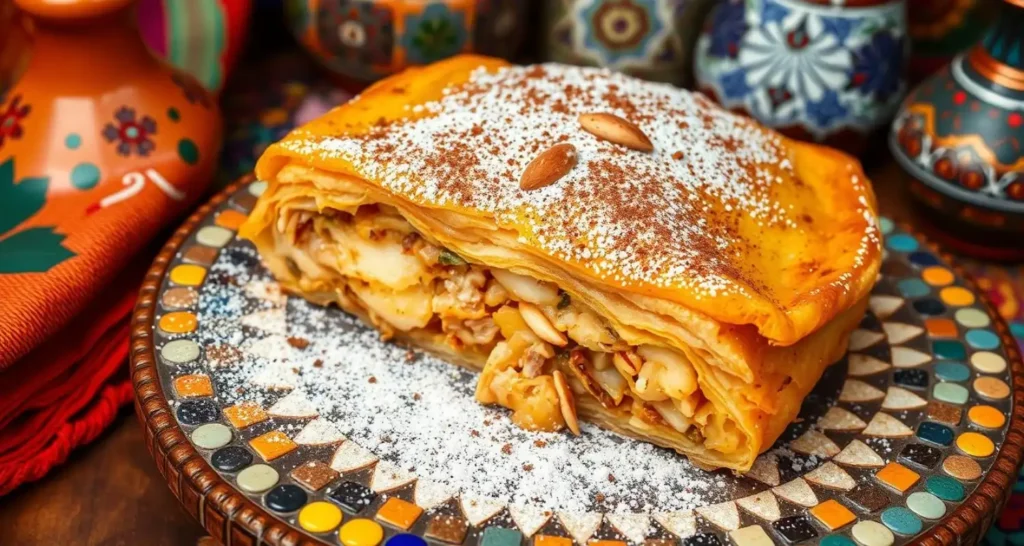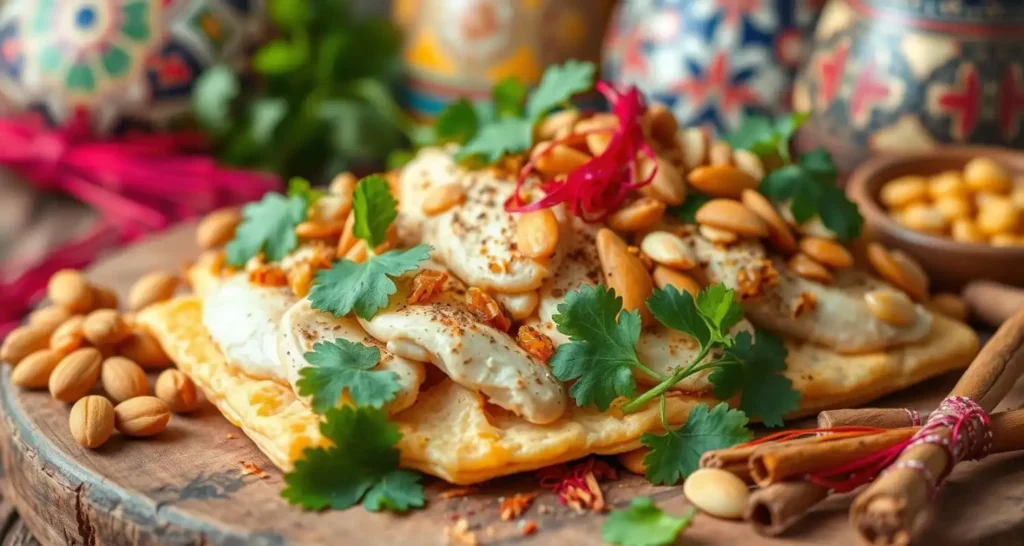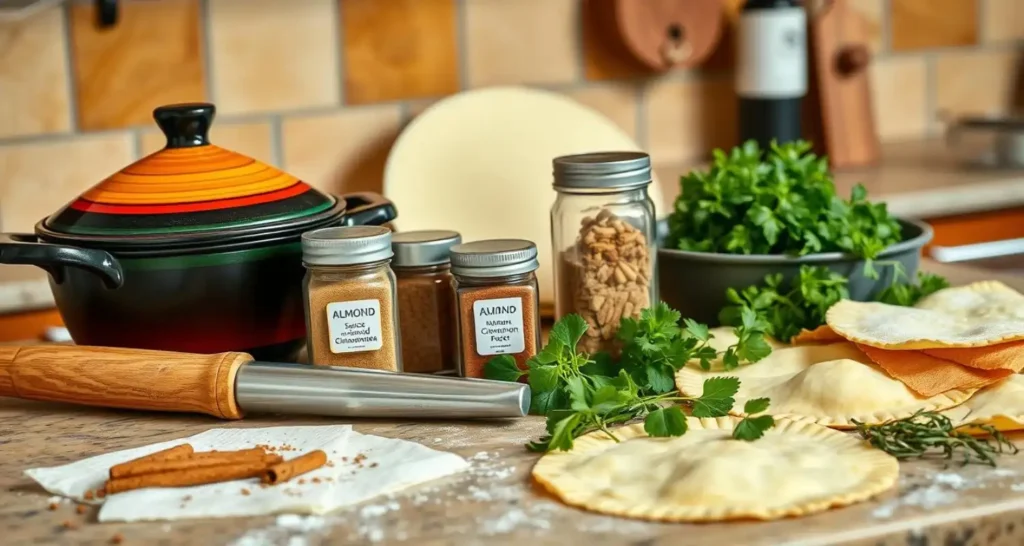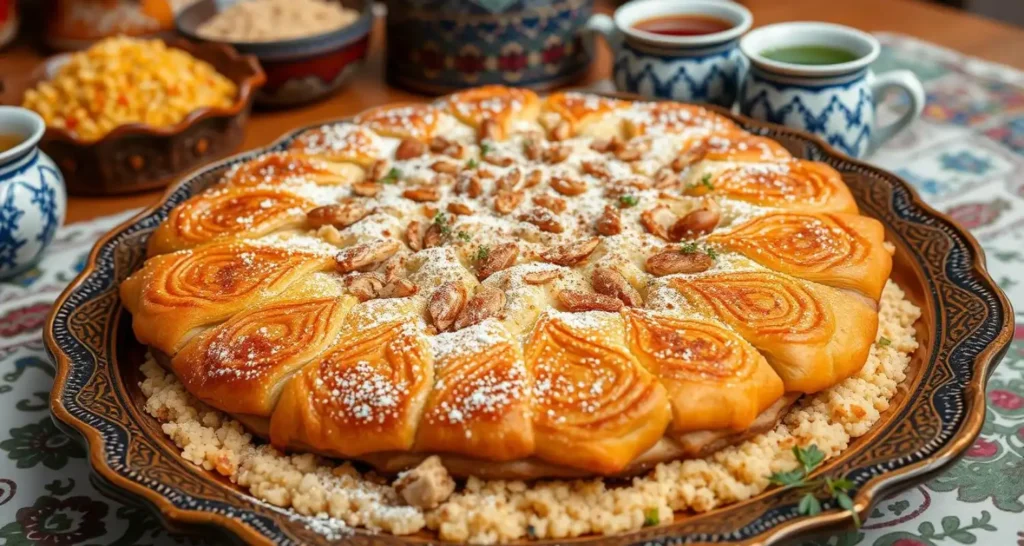Authentic Moroccan Pastilla Recipe: Traditional Savory Pie
Table of Contents
Walking through Morocco’s lively markets, you’re greeted by the scent of a favorite dish – the Moroccan pastilla. This pie, with its flaky phyllo dough and rich filling, has won over many hearts. Its mix of sweet and savory tastes, along with a hint of tradition, makes it a true culinary treasure.
Whether you’re an experienced cook or just starting, this Moroccan pastilla recipe will take you on a journey. It uses simple yet impressive ingredients, letting you dive into Morocco’s rich culture. Get ready to explore new flavors and enjoy the satisfaction of making this classic Moroccan dish.
Introduction to Moroccan Pastilla’s Rich Heritage
Moroccan pastilla, also known as bastilla, is a dish loved for centuries. With a perfectly flaky crust and fragrant fillings, it offers a burst of flavor in every bite. This pie is a big part of Moroccan culture.
Origins in North African Cuisine
The story of Moroccan pastilla starts in North Africa. Here, Mediterranean, Middle Eastern, and Berber flavors mix. This mix shows the region’s history of sharing food and ideas.
Cultural Significance in Morocco
In Morocco, pastilla is more than food. It’s a sign of welcome, joy, and pride. It’s served at big events like weddings and festivals, showing its importance.
Traditional Serving Occasions
- Weddings: Moroccan pastilla is key at weddings, the main dish of the feast.
- Births: Pastilla is made to welcome new life, a sign of nourishment.
- Religious Festivals: Pastilla is also a big part of religious holidays in Morocco.
The lasting impact of Moroccan pastillas shows the area’s rich food history. Its role in today’s Moroccan food shows its deep cultural value.

Essential Ingredients for Your Moroccan Pastilla
Making a real Moroccan Bastilla chicken needs the right mix of ingredients. Each part, from the flaky phyllo dough to the chicken filling, is crucial. Together, they bring out the true taste of this North African favorite.
The chicken is the heart of the pastilla. Infused with spices, it’s cooked until tender and deeply flavorful with Moroccan notes. The eggs and almonds add a creamy texture to the filling. Meanwhile, the phyllo dough makes the dish crispy and layered outside.
- Chicken, preferably thighs or a mix of dark and white meat
- Eggs, for binding and making a custard-like filling
- Almonds, toasted and ground, for crunch and nutty taste
- Phyllo dough, the delicate pastry that forms the flaky layers
- Onions, garlic, and Moroccan spices like cinnamon, ginger, and saffron, for authentic flavors
Looking for these ingredients might mean a visit to a specialty store or a Moroccan market. But it’s worth it to make this iconic Moroccan dish in your kitchen.

Kitchen Tools and Equipment Needed
To make a real Moroccan pastilla, you need the right tools. Embrace traditional methods while using modern tools for efficiency. Let’s look at what you’ll need to make this tasty dish at home.
Traditional vs Modern Cooking Tools
Traditionally, cooks used special tools like the Tangia clay pot and the mkharqa shallow pan. These tools add to the dish’s flavor and texture. But, modern cooks might find it easier to use common kitchen items like a heavy pot, a big skillet, and a rolling pin.
Preparing Your Workspace
- Make sure you have a clean, big work area for your pastilla.
- Have all your ingredients and tools ready, like a sharp knife, cutting board, pastry brush, and a big baking dish.
- Use parchment or a floured surface to prevent the phyllo from clinging.
- Keep a clean towel over the phyllo dough to keep it moist.
| Traditional Moroccan Pastilla Tools | Modern Equivalent Tools |
| Tangia (clay pot) | Heavy-bottomed pot or Dutch oven |
| Mkharqa (shallow pan) | Large skillet or griddle |
| Moroccan rolling pin | Standard rolling pin |
| Pastry brush | Pastry brush |
With the right tools and a clean workspace, you’re ready to make a delicious Moroccan pastilla at home.

Preparing the Chicken Filling
Making the perfect chicken pastilla or bastilla chicken filling is key. You start by cooking and seasoning the chicken. This blends its flavors with other ingredients.
Begin by simmering boneless, skinless chicken thighs in a flavorful broth. Cook until tender and fully cooked. Then, shred or finely chop the chicken and return it to the broth.
This step lets the chicken soak up the spices and herbs you add next.
- Warm Moroccan spices like cinnamon, ginger, and turmeric
- Fresh parsley and cilantro for a herbaceous note
- Sautéed onions and garlic for depth of flavor
- Toasted almonds or pine nuts for crunch and nuttiness
- Beaten eggs to bind the filling and create a creamy texture
It’s important to balance the chicken, spices, and textures. Taste and adjust the seasoning. Make sure the filling is well-seasoned and harmonious.
With the chicken filling ready, you’re almost there. Next, layer the phyllo dough to make the flaky crust.
Making the Perfect Pastilla Layers
Making the perfect Moroccan pastilla needs a gentle touch with phyllo dough. It’s all about layering to get that flaky, crisp crust. This crust wraps around the savory filling of this true Moroccan dish Bastilla.
Working with Phyllo Dough
Phyllo dough, the thin sheets at the heart of the Moroccan pastilla, can be hard to manage. Keep it covered with a damp cloth to stop it from drying. Speed is key when layering dough; unroll it delicately to maintain its integrity. Brush each layer with melted butter or oil for a golden, crisp finish.
Layering Techniques
The secret to a great Moroccan pastilla is in how you layer. Start with a circular pattern, letting sheets overlap a bit. Do this 8-10 times, making sure each layer gets butter or oil. This will give you a flaky, golden crust around the filling.
Avoiding Common Mistakes
- Don’t overwork the phyllo dough to avoid tears.
- Make sure to coat layers well with butter or oil to prevent a dry crust.
- Don’t overfill the pastilla to keep layers from getting soggy.
- Seal the edges well to stop leakage during baking.
With practice in working with phyllo dough and layering, you’ll make a delicious Moroccan pastilla.
The Art of Moroccan Pastilla Seasoning
Making a real Moroccan pastilla is more than layering and baking. It’s about the spices that make it special. The mix of sweet, earthy, and aromatic flavors creates a unique taste.
Cinnamon is key in Moroccan pastilla seasoning. It adds a warm, comforting taste. Saffron, from the crocus flower, gives a golden color and a floral hint that matches the spices well.
The real highlight is ras el hanout, a Moroccan spice mix. It varies by family but often includes cumin, ginger, black pepper, cardamom, and rose petals. This mix creates a rich flavor experience.
What makes a Moroccan pastilla stand out is balancing the flavors. It’s about mixing warm spices with the sweetness of the filling. Adjusting the spice amounts lets you make it your own.
| Spice | Function | Ideal Proportion |
| Cinnamon | Provides warmth and comfort | 1/2 teaspoon per 1 lb of filling |
| Saffron | Imparts a regal golden hue and floral notes | 1/4 teaspoon per 1 lb of filling |
| Ras el Hanout | Contributes a multi-dimensional richness to the taste profile. | 1 tablespoon per 1 lb of filling |
Whether you’re new to Moroccan cuisine or a fan, learning to season Moroccan pastilla is crucial. Try different amounts of spices until you find the perfect mix for your taste.
Step-by-Step Assembly Instructions
Making the perfect Moroccan chicken pastilla (also known as bastilla chicken) needs careful attention. Follow these steps to make your savory pie perfect every time.
Preparing the Bottom Layer
Lay a foundation by brushing the dish’s base with butter or oil. This keeps the phyllo dough from sticking. Lay down the first sheet of phyllo, brushing it with more butter or oil. Keep adding one sheet at a time, brushing each, until you have 6-8 sheets for a strong base.
Distributing the Chicken Filling
Distribute the chicken pastilla filling uniformly over the phyllo dough. Leave an inch of dough untouched at the edges for better results. Too much filling might cause overflow while in the oven.
Sealing the Pastilla
- Fold the overhanging phyllo dough over the filling, creating a neat envelope-like seal.
- Add the remaining phyllo sheets one by one, brushing each layer with butter or oil, to completely enclose the filling.
- Tuck the final sheet under the bottom layer, ensuring a tight, uniform shape.
By following these steps, you’ll get a Bastilla chicken pie that’s golden, flaky, and mess-free.
Baking Guidelines and Temperature Control
To make the perfect Moroccan pastilla, follow precise baking steps and control the temperature. This ensures your pie is golden-brown and flaky. Closely manage the heat and duration for optimal results.
For perfect results, warm the oven to 375°F (190°C) beforehand. This temperature cooks the Bastilla right and makes the crust golden. Bake between 45-55 minutes, ensuring the top doesn’t over-darken.
- Halfway through, rotate the pan for even heat. This prevents uneven cooking.
- The pastilla is done when the top is golden and a skewer comes out clean.
- Protect the crust from over-browning by adding a foil cover. This stops further browning while the inside cooks.
Every oven is different, so watch your Moroccan pastilla closely. Adjust the baking time as needed. With practice, you’ll get the flaky crust and tender filling just right.
“The secret to a delicious Moroccan pastilla lies in the perfect marriage of temperature and time.”
Traditional Garnishing and Presentation
The art of garnishing Moroccan pastilla is key to its charm. It’s the powdered sugar patterns that make it stand out. These patterns add elegance and beauty to the dish.
Decorative Powdered Sugar Patterns
Making these designs is a labor of love. A fine-mesh sieve is used to dust powdered sugar over the Moroccan dish Bastilla. This creates beautiful swirls and shapes.
Some patterns look like the sun, while others remind us of Moroccan tiles. These designs are not just pretty. They also carry deep cultural meaning, linking the pastilla to Moroccan heritage.
Accompaniment Suggestions
- Mint tea: The quintessential Moroccan beverage, mint tea, complements the savory and sweet notes of the pastilla perfectly.
- Fresh seasonal fruit: A light and refreshing accompaniment, such as sliced oranges or fresh figs, provides a counterpoint to the pastry’s richness.
- Toasted almonds or pistachios: Sprinkled over powdered sugar, these crunchy nuts add textural interest and a nutty flavor profile.
By using traditional garnishing and presentation for Moroccan pastilla, you can make it even more special. It becomes a memorable dish that honors Moroccan culture.
Storage and Reheating Tips
Making the perfect chicken pastilla is a big deal. But it’s not over when you’re done cooking. Keeping it fresh and crispy is key. Here’s how to enjoy your Moroccan pastilla even after the first time.
Storing Leftover Pastilla
After it cools, put the leftover pastilla in an airtight container. This keeps the flaky dough and filling moist. Store it in the fridge for up to 3 days, sealed tight to stay fresh.
Reheating for Crispy Perfection
To reheat your pastilla, aim for a crispy crust without drying out the inside. Here’s the trick:
- Preheat your oven to 375°F (190°C).
- Put the pastilla on a baking sheet with parchment paper.
- To get a crispy, golden finish, bake it for 10-15 minutes.
- Serve hot, with a sprinkle of powdered sugar for a Moroccan flair.
Avoid microwaving to keep the phyllo dough from getting soggy.
Freezing and Thawing Pastilla
Want to save some pastilla for later? Freeze it for up to 2 months. Wrap it in plastic or foil, then in a freezer-safe container. Thaw it in the fridge overnight to ensure it’s ready for reheating.
With these tips, you can enjoy the real taste of Moroccan Bastilla chicken again and again. Enjoy every bite!
Recipe Variations and Modern Adaptations
Pastilla, sometimes called Bastilla, is one of Morocco’s most prized dishes. But, it’s also open to new ideas and tastes. You can try seafood or vegetarian versions, making the pie a versatile treat.
Seafood Alternative
Reinvent the classic with a flavorful seafood alternative. Use shrimp, scallops, and white fish instead of chicken. The seafood’s delicate taste goes well with the spices and phyllo, making it a unique dish.
Vegetarian Options
- Mushroom and Spinach Pastilla: A vegetarian version that combines sautéed mushrooms, spinach, and herbs, delivering the authentic Moroccan pastilla flavor in each bite.
- Butternut Squash and Lentil Pastilla: Roast butternut squash and mix it with lentils, spices, and honey. It’s a warm, earthy twist on the classic.
- Roasted Vegetable Pastilla: Fill it with roasted bell peppers, zucchini, onions, and Moroccan spices. Layer it in flaky phyllo dough.
These Bastilla recipes let you explore Moroccan pastilla while meeting different dietary needs. Whether you love seafood or prefer vegetables, there’s a pastilla for you. It’s a way to enjoy Moroccan cuisine and its rich heritage.
| Variation | Key Ingredients | Flavor Profile |
| Seafood Pastilla | Shrimp, scallops, white fish | Delicate, briny, aromatic |
| Mushroom and Spinach Pastilla | Mushrooms, spinach, herbs | Earthy, savory, nutrient-rich |
| Butternut Squash and Lentil Pastilla | Butternut squash, lentils, spices | Warm, comforting, protein-packed |
| Roasted Vegetable Pastilla | Bell peppers, zucchini, onions | Vibrant, flavorful, satisfying |
Conclusion
The Moroccan pastilla is a true culinary gem. It shows off the rich culture and tastes of North Africa. This savory pie has been a favorite in Morocco for centuries, especially at special times.
Learning to make Moroccan pastilla is more than just cooking. It’s a wonderful way to experience the essence of Morocco’s food history. The mix of tender chicken, aromatic spices, and flaky phyllo dough is a treat for your senses. It offers a taste of Morocco’s bustling markets and vibrant urban life.
Whether you make it for a big event or a cozy dinner, this recipe will be a favorite. Share the joy of Moroccan pastilla with those closest to you. Let them experience the amazing flavors and cultural importance of this Moroccan dish Bastilla.
FAQ
What is a Moroccan pastilla?
Moroccan pastilla is a flavorful pie, prized for its crispy layers and harmonious blend of sweet and savory.
What are the origins of Moroccan pastilla?
Moroccan pastilla comes from North Africa’s rich food traditions. It holds deep cultural value in Morocco. It’s often enjoyed during special events and celebrations.
What are the key ingredients in Moroccan pastilla?
To make authentic Moroccan pastilla, you need phyllo dough, chicken, eggs, almonds, and spices. Spices like cinnamon, saffron, and ras el hanout are part of the combination.
What kitchen tools and equipment are needed to make Moroccan pastilla?
You’ll need traditional and modern tools to make Moroccan pastilla. This includes a pastry brush, a large baking dish, and a clean workspace. This helps you organize your ingredients and tools efficiently.
How do I prepare the chicken filling for Moroccan pastilla?
The chicken filling is crucial for a great Moroccan pastilla. Cook and season the chicken well. Then, mix in eggs and almonds for the right flavors and textures.
How do I work with the phyllo dough for Moroccan pastilla?
Working with phyllo dough requires care. But, with the right techniques, you can achieve a crispy, flaky crust. Learn to avoid mistakes for the best results.
What spices are used in Moroccan pastilla?
Moroccan pastilla uses a complex spice blend. It includes cinnamon, saffron, and ras el hanout. Getting the balance of sweet and savory flavors is key for an authentic taste.
How do I assemble and bake Moroccan pastilla?
Assembling Moroccan pastilla needs careful layering and filling distribution. Sealing it properly is also important. Baking at the right temperature and time is crucial for a perfect pastilla.
How do I present and serve Moroccan pastillas?
Powdered sugar is often used to create decorative motifs on top of pastilla. It’s served with other dishes and drinks to enhance its flavors.
How do I store and reheat leftover Moroccan pastilla?
Storing and reheating Moroccan pastillas correctly is important. Learn how to keep it crispy when reheating leftovers.
Are there any variations or modern adaptations of Moroccan pastilla?
Yes, there are seafood and vegetarian versions of Moroccan pastilla. Modern twists on the classic dish are also popular.
